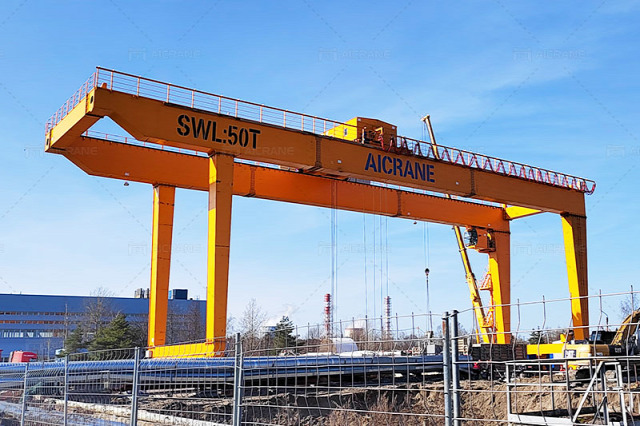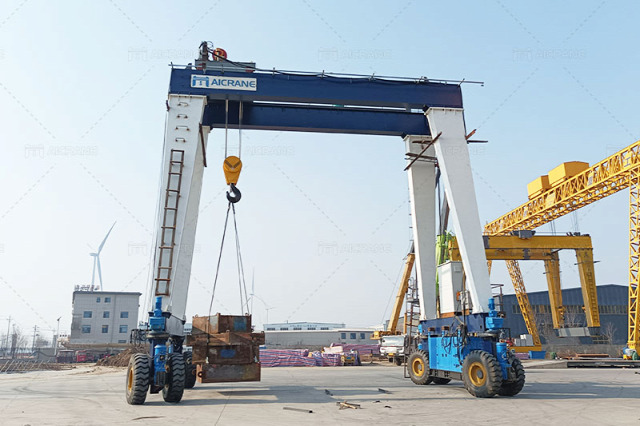The 50-ton gantry crane market has experienced significant fluctuations in price over the years. These cranes are vital for lifting heavy loads in a wide range of industries, including construction, shipping, steel production, and more. Understanding the factors that influence the price of 50-ton gantry cranes can help buyers make informed purchasing decisions. This article delves into the key drivers of price fluctuations, the reasons behind these changes, and how businesses can navigate the complexities of purchasing these heavy-duty cranes.

1. Market Demand and Supply
One of the primary factors influencing the 50 ton gantry crane price is market demand and supply. The demand for these cranes is closely tied to the industries that rely on them for heavy lifting. As industrialization progresses in regions with growing infrastructure and construction sectors, the demand for cranes increases. Similarly, shipping and port industries are growing globally, especially in emerging markets, where trade activities require heavy-duty lifting solutions for containers, steel, and other materials.
When demand outstrips supply, crane manufacturers face increased pressure to meet orders. This scenario often results in higher prices due to limited availability. Conversely, in periods of lower demand, crane prices may decrease as manufacturers seek to move inventory. As global trade and industrial activities fluctuate, so too does the demand for gantry cranes, contributing to price variations.
2. Raw Material Prices
The cost of raw materials used in the construction of 50-ton gantry cranes, such as steel, aluminum, and other metals, is another significant factor affecting pricing. The prices of raw materials are subject to global market conditions, geopolitical tensions, and trade policies. For example, the global steel market has seen significant price changes due to fluctuations in supply and demand, often influenced by factors like international tariffs, mining strikes, or changes in trade agreements.
When the price of raw materials rises, manufacturers may face higher production costs, which are typically passed on to the consumer. Conversely, when raw material prices drop, crane prices may stabilize or decrease. Buyers need to be aware of these external factors and how they impact the cost of cranes.

3. Technological Advancements
Technological innovations and upgrades also play a crucial role in shaping the gantry crane price. The integration of new features such as improved automation, anti-sway systems, and advanced control mechanisms can increase the cost of production. As manufacturers incorporate new technologies to meet the needs of industries like construction and shipping, they often charge higher prices for cranes equipped with these advanced systems.
However, technological advancements also improve crane efficiency, safety, and performance, which may justify the higher price for many buyers. For example, cranes with automated load monitoring systems, better energy efficiency, and more ergonomic controls are priced higher but offer long-term operational benefits. Thus, buyers should weigh the upfront costs against the expected performance and efficiency gains when considering technological upgrades.
4. Labor and Manufacturing Costs
The labor costs associated with manufacturing 50-ton gantry cranes also affect the final price. Manufacturing these cranes requires skilled labor and specialized equipment, which can drive up production costs. Labor costs may vary significantly depending on the country or region where the cranes are produced. Countries with higher wage standards may see higher crane prices due to the cost of skilled labor, while countries with lower wage standards may offer more competitive pricing.
Additionally, manufacturing methods—such as custom-built cranes versus mass-produced units—can influence pricing. Customized gantry cranes often come with a premium price due to the design and engineering work required, as well as the specialized components used. Businesses looking for tailored solutions may have to pay more, but they can benefit from a crane that is specifically suited to their operational needs.
5. Government Regulations and Standards
Government regulations and standards can have a profound impact on the cost of 50-ton gantry cranes. Countries and regions have varying safety and environmental regulations that affect the design and manufacturing of cranes. For example, stricter safety requirements may necessitate additional features, such as enhanced braking systems, load sensors, or improved anti-collision systems, all of which increase production costs.
Environmental regulations, such as emission standards and energy efficiency requirements, can also raise the cost of manufacturing. Cranes that meet these higher standards often cost more to produce due to the need for specialized materials and components. However, these regulations may also benefit the industry in the long term by ensuring safer, more energy-efficient equipment, reducing operating costs for users.
6. Geopolitical Factors and Trade Policies
Geopolitical tensions and trade policies can have a significant impact on the pricing of heavy-duty equipment like 50-ton gantry cranes. Tariffs, trade wars, and sanctions can cause shifts in the cost of materials and parts, leading to increased crane prices. For instance, a trade dispute between major economies such as the United States and China could affect the price of raw materials like steel, which are crucial to crane manufacturing.
Similarly, changes in international shipping regulations, customs duties, and import-export taxes can increase or decrease the cost of cranes depending on the location of the buyer and the manufacturer. Companies in regions facing higher tariffs may experience price hikes as manufacturers pass along these added costs. Buyers should consider the geopolitical landscape when planning a crane purchase, as these factors may influence pricing and lead times.
7. Currency Exchange Rates
Fluctuations in currency exchange rates can also impact the price of 50-ton gantry cranes, especially when cranes are purchased from overseas manufacturers. A strong domestic currency can make importing heavy machinery more affordable, while a weak currency may drive up prices. For example, if a buyer in Europe is purchasing a crane from a manufacturer in Asia, fluctuations in the Euro-to-Yuan or Euro-to-Dollar exchange rate could increase the cost of the crane.
Companies that import cranes or crane components should monitor exchange rates and consider purchasing when rates are favorable to reduce costs. Forward contracts and hedging strategies may help companies lock in favorable exchange rates, thereby mitigating the risk of price fluctuations due to currency changes.
8. Competition and Market Conditions
The level of competition within the crane manufacturing industry also plays a role in price fluctuations. When competition is high, manufacturers may lower prices to gain market share, especially if they are looking to expand into new regions. However, when competition is limited due to high barriers to entry, companies may increase their prices, knowing that customers have few alternative options.
Additionally, mergers and acquisitions within the crane industry can alter market dynamics, affecting supply and demand, and ultimately impacting prices. Changes in market conditions, such as a sudden rise in infrastructure projects or a slowdown in economic growth, can create price volatility in the crane market.
9. Seasonality
Seasonality can also influence the price of 50-ton gantry cranes. In some industries, demand for heavy lifting equipment is cyclical. For instance, the construction industry may experience peak demand during certain seasons, such as spring and summer, leading to price increases during these periods. Conversely, during off-seasons, when fewer construction projects are underway, crane prices may decrease as manufacturers seek to maintain production volumes.
Buyers may want to time their purchases to align with periods of lower demand to secure more competitive pricing. However, it is essential to plan ahead to avoid delays in crane delivery, as manufacturers may experience backlogs during peak periods.
10. Conclusion
Understanding the price fluctuations in the 50-ton gantry crane market is essential for businesses looking to invest in this heavy-duty equipment. Prices are influenced by a wide range of factors, including market demand, raw material costs, technological advancements, labor costs, government regulations, geopolitical conditions, currency exchange rates, competition, and seasonality. By staying informed about these factors, buyers can make well-timed purchasing decisions that help them secure the best value for their investment in gantry cranes.
Moreover, as the market continues to evolve, staying ahead of trends and understanding the broader economic landscape will allow businesses to make informed choices and successfully navigate the complexities of purchasing heavy machinery.

